《数据库系统概念 Database System Concepts》原书教学资源(第五版,PPT课件讲稿,英文版)Chapter 13 Query Processing
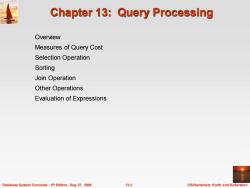
Chapter 13:Query Processing Overview Measures of Query Cost Selection Operation Sorting Join Operation Other Operations Evaluation of Expressions Database System Concepts-5th Edition,Aug 27,2005. 13.2 @Silberschatz,Korth and Sudarshan
Database System Concepts - 5 13.2 ©Silberschatz, Korth and Sudarshan th Edition, Aug 27, 2005. Chapter 13: Query Processing Overview Measures of Query Cost Selection Operation Sorting Join Operation Other Operations Evaluation of Expressions
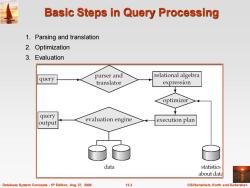
Basic Steps in Query Processing 1.Parsing and translation 2.Optimization 3.Evaluation parser and relational algebra query translator expression optimizer query output evaluation engine execution plan data statistics about data Database System Concepts-5th Edition,Aug 27,2005. 13.3 ©Silberschat乜,Korth and Sudarshan
Database System Concepts - 5 13.3 ©Silberschatz, Korth and Sudarshan th Edition, Aug 27, 2005. Basic Steps in Query Processing 1. Parsing and translation 2. Optimization 3. Evaluation
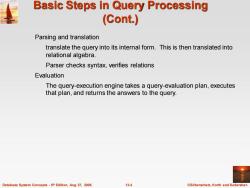
Basic Steps in Query Processing (Cont.) Parsing and translation translate the query into its internal form.This is then translated into relational algebra. Parser checks syntax,verifies relations Evaluation The query-execution engine takes a query-evaluation plan,executes that plan,and returns the answers to the query. Database System Concepts-5th Edition,Aug 27,2005. 13.4 @Silberschatz,Korth and Sudarshan
Database System Concepts - 5 13.4 ©Silberschatz, Korth and Sudarshan th Edition, Aug 27, 2005. Basic Steps in Query Processing (Cont.) Parsing and translation translate the query into its internal form. This is then translated into relational algebra. Parser checks syntax, verifies relations Evaluation The query-execution engine takes a query-evaluation plan, executes that plan, and returns the answers to the query
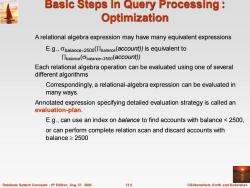
Basic Steps in Query Processing Optimization A relational algebra expression may have many equivalent expressions E.g.,balance<2500(Ibalance(account))is equivalent to Ibalance(balance<2500(account)) Each relational algebra operation can be evaluated using one of several different algorithms Correspondingly,a relational-algebra expression can be evaluated in many ways. Annotated expression specifying detailed evaluation strategy is called an evaluation-plan. E.g.,can use an index on balance to find accounts with balance 2500, or can perform complete relation scan and discard accounts with balance≥2500 Database System Concepts-5th Edition,Aug 27,2005. 13.5 ©Silberschat乜,Korth and Sudarshan
Database System Concepts - 5 13.5 ©Silberschatz, Korth and Sudarshan th Edition, Aug 27, 2005. Basic Steps in Query Processing : Optimization A relational algebra expression may have many equivalent expressions E.g., balance2500(balance(account)) is equivalent to balance(balance2500(account)) Each relational algebra operation can be evaluated using one of several different algorithms Correspondingly, a relational-algebra expression can be evaluated in many ways. Annotated expression specifying detailed evaluation strategy is called an evaluation-plan. E.g., can use an index on balance to find accounts with balance < 2500, or can perform complete relation scan and discard accounts with balance 2500
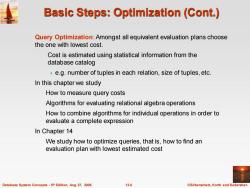
Basic Steps:Optimization (Cont.) Query Optimization:Amongst all equivalent evaluation plans choose the one with lowest cost. Cost is estimated using statistical information from the database catalog e.g.number of tuples in each relation,size of tuples,etc. In this chapter we study How to measure query costs Algorithms for evaluating relational algebra operations How to combine algorithms for individual operations in order to evaluate a complete expression In Chapter 14 We study how to optimize queries,that is,how to find an evaluation plan with lowest estimated cost Database System Concepts-5th Edition,Aug 27,2005. 13.6 @Silberschatz,Korth and Sudarshan
Database System Concepts - 5 13.6 ©Silberschatz, Korth and Sudarshan th Edition, Aug 27, 2005. Basic Steps: Optimization (Cont.) Query Optimization: Amongst all equivalent evaluation plans choose the one with lowest cost. Cost is estimated using statistical information from the database catalog e.g. number of tuples in each relation, size of tuples, etc. In this chapter we study How to measure query costs Algorithms for evaluating relational algebra operations How to combine algorithms for individual operations in order to evaluate a complete expression In Chapter 14 We study how to optimize queries, that is, how to find an evaluation plan with lowest estimated cost
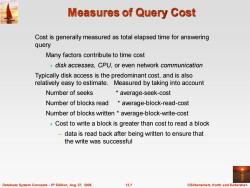
Measures of Query Cost Cost is generally measured as total elapsed time for answering query Many factors contribute to time cost disk accesses,CPU,or even network communication Typically disk access is the predominant cost,and is also relatively easy to estimate.Measured by taking into account Number of seeks average-seek-cost Number of blocks read average-block-read-cost Number of blocks written average-block-write-cost Cost to write a block is greater than cost to read a block -data is read back after being written to ensure that the write was successful Database System Concepts-5th Edition,Aug 27,2005. 13.7 @Silberschatz,Korth and Sudarshan
Database System Concepts - 5 13.7 ©Silberschatz, Korth and Sudarshan th Edition, Aug 27, 2005. Measures of Query Cost Cost is generally measured as total elapsed time for answering query Many factors contribute to time cost disk accesses, CPU, or even network communication Typically disk access is the predominant cost, and is also relatively easy to estimate. Measured by taking into account Number of seeks * average-seek-cost Number of blocks read * average-block-read-cost Number of blocks written * average-block-write-cost Cost to write a block is greater than cost to read a block – data is read back after being written to ensure that the write was successful
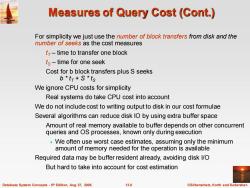
Measures of Query Cost (Cont.) For simplicity we just use the number of block transfers from disk and the number of seeks as the cost measures f-time to transfer one block ts-time for one seek Cost for b block transfers plus S seeks b *t+S *ts We ignore CPU costs for simplicity Real systems do take CPU cost into account We do not include cost to writing output to disk in our cost formulae Several algorithms can reduce disk IO by using extra buffer space Amount of real memory available to buffer depends on other concurrent queries and OS processes,known only during execution We often use worst case estimates,assuming only the minimum amount of memory needed for the operation is available Required data may be buffer resident already,avoiding disk l/O But hard to take into account for cost estimation Database System Concepts-5th Edition,Aug 27,2005. 13.8 ©Silberschat乜,Korth and Sudarshan
Database System Concepts - 5 13.8 ©Silberschatz, Korth and Sudarshan th Edition, Aug 27, 2005. Measures of Query Cost (Cont.) For simplicity we just use the number of block transfers from disk and the number of seeks as the cost measures tT – time to transfer one block tS – time for one seek Cost for b block transfers plus S seeks b * tT + S * tS We ignore CPU costs for simplicity Real systems do take CPU cost into account We do not include cost to writing output to disk in our cost formulae Several algorithms can reduce disk IO by using extra buffer space Amount of real memory available to buffer depends on other concurrent queries and OS processes, known only during execution We often use worst case estimates, assuming only the minimum amount of memory needed for the operation is available Required data may be buffer resident already, avoiding disk I/O But hard to take into account for cost estimation
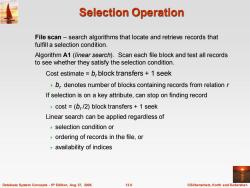
Selection Operation File scan-search algorithms that locate and retrieve records that fulfill a selection condition. Algorithm A1 (linear search).Scan each file block and test all records to see whether they satisfy the selection condition. Cost estimate b,block transfers +1 seek b,denotes number of blocks containing records from relation r If selection is on a key attribute,can stop on finding record cost =(b,/2)block transfers +1 seek Linear search can be applied regardless of selection condition or ordering of records in the file,or availability of indices Database System Concepts-5th Edition,Aug 27,2005. 13.9 ©Silberschat乜,Korth and Sudarshan
Database System Concepts - 5 13.9 ©Silberschatz, Korth and Sudarshan th Edition, Aug 27, 2005. Selection Operation File scan – search algorithms that locate and retrieve records that fulfill a selection condition. Algorithm A1 (linear search). Scan each file block and test all records to see whether they satisfy the selection condition. Cost estimate = br block transfers + 1 seek br denotes number of blocks containing records from relation r If selection is on a key attribute, can stop on finding record cost = (br /2) block transfers + 1 seek Linear search can be applied regardless of selection condition or ordering of records in the file, or availability of indices
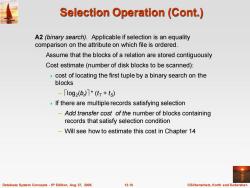
Selection Operation (Cont. A2(binary search).Applicable if selection is an equality comparison on the attribute on which file is ordered. Assume that the blocks of a relation are stored contiguously Cost estimate(number of disk blocks to be scanned): cost of locating the first tuple by a binary search on the blocks -log2(b)*(t+ts) If there are multiple records satisfying selection -Add transfer cost of the number of blocks containing records that satisfy selection condition Will see how to estimate this cost in Chapter 14 Database System Concepts-5th Edition,Aug 27,2005. 13.10 ©Silberschat乜,Korth and Sudarshan
Database System Concepts - 5 13.10 ©Silberschatz, Korth and Sudarshan th Edition, Aug 27, 2005. Selection Operation (Cont.) A2 (binary search). Applicable if selection is an equality comparison on the attribute on which file is ordered. Assume that the blocks of a relation are stored contiguously Cost estimate (number of disk blocks to be scanned): cost of locating the first tuple by a binary search on the blocks – log2 (br ) * (tT + tS) If there are multiple records satisfying selection – Add transfer cost of the number of blocks containing records that satisfy selection condition – Will see how to estimate this cost in Chapter 14
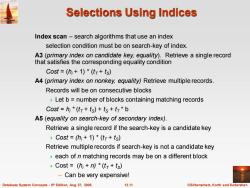
Selections Using Indices Index scan -search algorithms that use an index selection condition must be on search-key of index A3(primary index on candidate key,equality).Retrieve a single record that satisfies the corresponding equality condition Cost=(hi+1)*(tT+ts) A4(primary index on nonkey,equality)Retrieve multiple records. Records will be on consecutive blocks Let b number of blocks containing matching records Cost=hi *(tr+ts)+ts+tr*b A5(equality on search-key of secondary index). Retrieve a single record if the search-key is a candidate key Cost =(hi+1)*(tr+ts) Retrieve multiple records if search-key is not a candidate key each of n matching records may be on a different block Cost=(h;+n)*(t+ts) Can be very expensive! Database System Concepts-5th Edition,Aug 27,2005. 13.11 @Silberschatz,Korth and Sudarshan
Database System Concepts - 5 13.11 ©Silberschatz, Korth and Sudarshan th Edition, Aug 27, 2005. Selections Using Indices Index scan – search algorithms that use an index selection condition must be on search-key of index. A3 (primary index on candidate key, equality). Retrieve a single record that satisfies the corresponding equality condition Cost = (hi + 1) * (tT + tS) A4 (primary index on nonkey, equality) Retrieve multiple records. Records will be on consecutive blocks Let b = number of blocks containing matching records Cost = hi * (tT + tS) + tS + tT * b A5 (equality on search-key of secondary index). Retrieve a single record if the search-key is a candidate key Cost = (hi + 1) * (tT + tS) Retrieve multiple records if search-key is not a candidate key each of n matching records may be on a different block Cost = (hi + n) * (tT + tS) – Can be very expensive!
按次数下载不扣除下载券;
注册用户24小时内重复下载只扣除一次;
顺序:VIP每日次数-->可用次数-->下载券;
- 《数据库系统概念 Database System Concepts》原书教学资源(第五版,PPT课件讲稿,英文版)Chapter 12 Indexing and Hashing.ppt
- 《数据库系统概念 Database System Concepts》原书教学资源(第五版,PPT课件讲稿,英文版)Chapter 11 Storage and File Structure.ppt
- 《数据库系统概念 Database System Concepts》原书教学资源(第五版,PPT课件讲稿,英文版)Chapter 10 XML.ppt
- 《数据库系统概念 Database System Concepts》原书教学资源(第五版,PPT课件讲稿,英文版)Chapter 1 Introduction(Avi Silberschatz Henry F. Korth S. Sudarshan).ppt
- 《数据库系统概念 Database System Concepts》原书教学资源(第五版,附录,英文版)Appendix C Advanced Relational Database Design.ppt
- 《数据库系统概念 Database System Concepts》原书教学资源(第五版,附录,英文版)Chapter B Hierarchical Model.ppt
- 《数据库系统概念 Database System Concepts》原书教学资源(第五版,附录,英文版)Chapter A Network Model.ppt
- 《数据库系统概念 Database System Concepts》原书教学资源(第六版,附录,英文版)Hierarchical Model.pdf
- 《数据库系统概念 Database System Concepts》原书教学资源(第六版,附录,英文版)Network Model.pdf
- 《数据库系统概念 Database System Concepts》原书教学资源(第六版,附录,英文版)Other Relational Query Languages.pdf
- 《数据库系统概念 Database System Concepts》原书教学资源(第六版,附录,英文版)Advanced Relational Database Design.pdf
- 《数据库系统概念 Database System Concepts》原书教学资源(第六版,PPT课件讲稿,英文版)Chapter 9 Application Design and Development.ppt
- 《数据库系统概念 Database System Concepts》原书教学资源(第六版,PPT课件讲稿,英文版)Chapter 8 Relational Database Design.ppt
- 《数据库系统概念 Database System Concepts》原书教学资源(第六版,PPT课件讲稿,英文版)Chapter 7 Database Design - The Entity-Relationship Approach.ppt
- 《数据库系统概念 Database System Concepts》原书教学资源(第六版,PPT课件讲稿,英文版)Chapter 6 Formal Relational Query Languages.ppt
- 《数据库系统概念 Database System Concepts》原书教学资源(第六版,PPT课件讲稿,英文版)Chapter 5 Advanced SQL.ppt
- 《数据库系统概念 Database System Concepts》原书教学资源(第六版,PPT课件讲稿,英文版)Chapter 4 Intermediate SQL.ppt
- 《数据库系统概念 Database System Concepts》原书教学资源(第六版,PPT课件讲稿,英文版)Chapter 3 Introduction to SQL.ppt
- 《数据库系统概念 Database System Concepts》原书教学资源(第六版,PPT课件讲稿,英文版)Chapter 26 Advanced Transaction Processing.ppt
- 《数据库系统概念 Database System Concepts》原书教学资源(第六版,PPT课件讲稿,英文版)Chapter 25 Advanced Data Types and New Applications.ppt
- 《数据库系统概念 Database System Concepts》原书教学资源(第五版,PPT课件讲稿,英文版)Chapter 14 Query Optimization.ppt
- 《数据库系统概念 Database System Concepts》原书教学资源(第五版,PPT课件讲稿,英文版)Chapter 15 Transactions.ppt
- 《数据库系统概念 Database System Concepts》原书教学资源(第五版,PPT课件讲稿,英文版)Chapter 16 Concurrency Control.ppt
- 《数据库系统概念 Database System Concepts》原书教学资源(第五版,PPT课件讲稿,英文版)Chapter 17 Recovery System.ppt
- 《数据库系统概念 Database System Concepts》原书教学资源(第五版,PPT课件讲稿,英文版)Chapter 18 Data Analysis and Mining.ppt
- 《数据库系统概念 Database System Concepts》原书教学资源(第五版,PPT课件讲稿,英文版)Chapter 19 Information Retrieval.ppt
- 《数据库系统概念 Database System Concepts》原书教学资源(第五版,PPT课件讲稿,英文版)Chapter 2 Relational Model.ppt
- 《数据库系统概念 Database System Concepts》原书教学资源(第五版,PPT课件讲稿,英文版)Chapter 20 Database System Architectures.ppt
- 《数据库系统概念 Database System Concepts》原书教学资源(第五版,PPT课件讲稿,英文版)Chapter 21 Parallel Databases.ppt
- 《数据库系统概念 Database System Concepts》原书教学资源(第五版,PPT课件讲稿,英文版)Chapter 22 Distributed Databases.ppt
- 《数据库系统概念 Database System Concepts》原书教学资源(第五版,PPT课件讲稿,英文版)Chapter 23 Advanced Application Development.ppt
- 《数据库系统概念 Database System Concepts》原书教学资源(第五版,PPT课件讲稿,英文版)Chapter 24 Advanced Data Types.ppt
- 《数据库系统概念 Database System Concepts》原书教学资源(第五版,PPT课件讲稿,英文版)Chapter Advanced Transaction Processing.ppt
- 《数据库系统概念 Database System Concepts》原书教学资源(第五版,PPT课件讲稿,英文版)Chapter 3 SQL.ppt
- 《数据库系统概念 Database System Concepts》原书教学资源(第五版,PPT课件讲稿,英文版)Chapter 4 Advanced SQL.ppt
- 《数据库系统概念 Database System Concepts》原书教学资源(第五版,PPT课件讲稿,英文版)Chapter 5 Other Relational Languages.ppt
- 《数据库系统概念 Database System Concepts》原书教学资源(第五版,PPT课件讲稿,英文版)Chapter 6 Entity-Relationship Model.ppt
- 《数据库系统概念 Database System Concepts》原书教学资源(第五版,PPT课件讲稿,英文版)Chapter 7 Relational Database Design.ppt
- 《数据库系统概念 Database System Concepts》原书教学资源(第五版,PPT课件讲稿,英文版)Chapter 8 Application Design and Development.ppt
- 《数据库系统概念 Database System Concepts》原书教学资源(第五版,PPT课件讲稿,英文版)Chapter 9 Object-Based Databases.ppt
